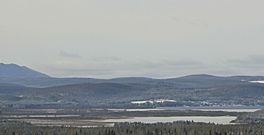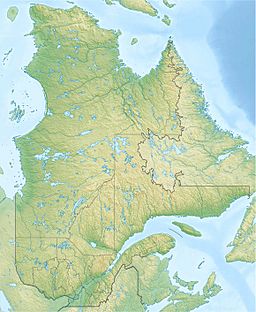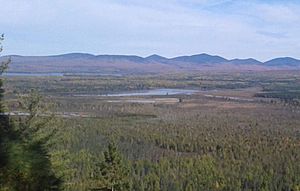Lac des Joncs (Mégantic) facts for kids
Quick facts for kids Lac des Joncs |
|
|---|---|

The Lac des Joncs covered with ice, in the foreground, surrounded by the also frozen marsh. The unfrozen part at the back is Lac Mégantic. (view from Chemin Louise-Bocage).
|
|
| Location | Canada, Quebec, Estrie, Le Granit Regional County Municipality |
| Coordinates | 45°27′03″N 70°50′59″W / 45.45072°N 70.84977°W |
| Primary inflows | Rivière aux Araignées |
| Primary outflows | Rivière aux Araignées |
| Max. length | 1.0 kilometre (0.62 mi) |
| Max. width | 0.6 kilometres (0.37 mi) |
| Surface elevation | 395 metres (1,296 ft) |
| Frozen | Surface of the lake is generally frozen from mid-December to mid-March |
The Lac des Joncs, also known as Joncs Lake, is a marshy pond. It is located in the town of Piopolis, in the Le Granit Regional County Municipality. This area is part of the Estrie region in Quebec, Canada.
Where is Lac des Joncs?
Lac des Joncs sits about 395 meters (1,296 feet) above sea level. It is about 1 kilometer (0.6 miles) long and 600 meters (0.4 miles) wide. This pond is part of the larger Lac Mégantic marsh system. This marsh area covers about 5 square kilometers (1.9 square miles).
Rivers and Connections
Lac des Joncs is found between two other lakes: Lac aux Araignées and Lake Mégantic. The main river flowing into Lac des Joncs is the Rivière aux Araignées. This river actually flows right through the pond. After leaving Lac des Joncs, the river continues towards Lake Mégantic. The Arnold River also joins this system south of Lac Mégantic.
Wildlife Around the Lake
The area around Lac des Joncs and its marshes is home to many different birds. Nearly 127 types of birds visit these lakes and marshes. You might see brent geese during their long migrations. The bald eagle, which is quite rare in Quebec, also visits this special place.



